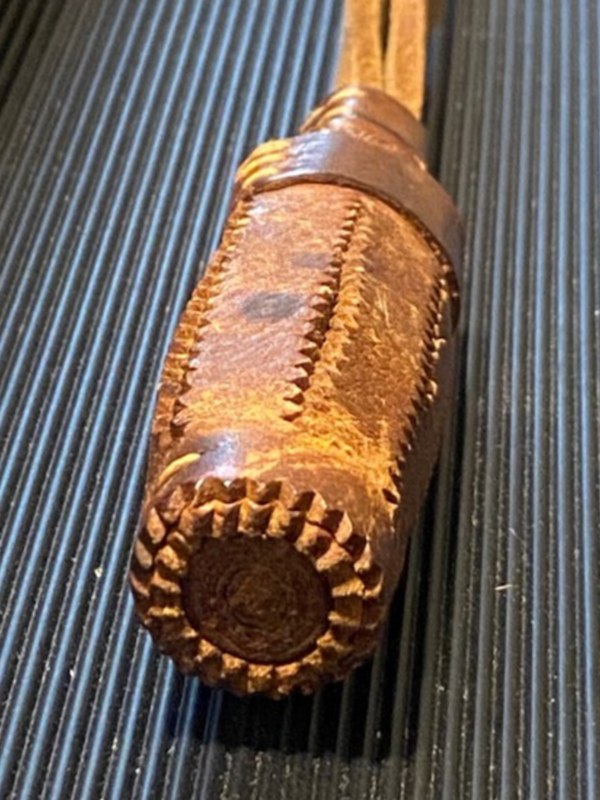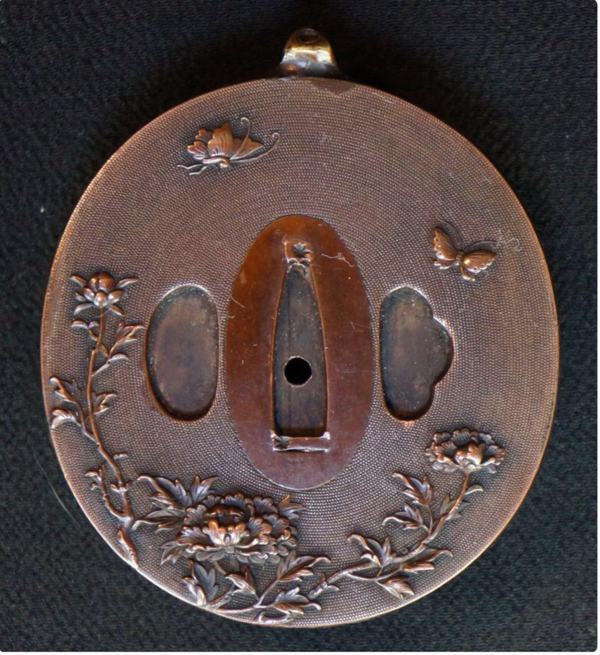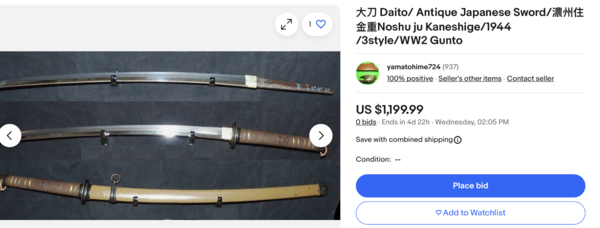
John C
Members-
Posts
2,210 -
Joined
-
Last visited
-
Days Won
15
Content Type
Profiles
Forums
Events
Store
Downloads
Gallery
Everything posted by John C
-
Hello: I just picked up this fukuro yari signed on the socket Chikuzen Shimosaka. Please note the small cross piece on the upper shaft. Would I be correct in assuming this makes it an inoshishi yari? If so, were these used exclusively for boar hunting or could they also have been used as a weapon? Bonji script on both sides of the blade (needs a polish); first red then black lacquer applied to the socket, but rubbed off by someone to read the mei; two small mekugi ana at right angles on the socket; overall length about 9 feet. Thanks for looking, John C.
-
I'll help you out, Bruce. I read a post where you showed a picture of your tassels. They all had the "collar" on the top (which is what prompted my question, actually). Thanks for the pic, Sam. I read through Nick's stuff and didn't see that document. I too have his "Master List" of articles bookmarked. John C. p.s. as a leather worker, I can replace the collar at the top and make it look original, if necessary.
-
These are some of the recurring marks on the 1892 Meiji 25 swords. The circled mark is from a document referencing production numbers from type 95s. It's too blurry for me to make out, however the circled mark looks very similar to the 1892 marks. If they are the same, then it explains the meaning of the mark (being made the Iijima branch). Hope that clarifies, John C.
-
Thought of new idea, electroforming of swords and knives
John C replied to Mustafa Umut Sarac's topic in Nihonto
Mustafa: I suggest you use your knowledge of archaeology and provide input on the history of Japanese swords. We study Japanese swords for their aesthetic value as well as their performance value in relation to other swords and steels of the time. Comparing apples to apples, as we would say. If you have input on the relationship between Japanese steel and steel of other cultures from the same time period (1300 to 1800, let's say), we would love to hear it. John C. -
Hello: I'm trying to determine if the tassel on the patrolman sword is in original condition. In researching other threads, the consensus seems to be the ones with the "collar" at the top (see pic 2 for reference) are original, which the one on the sword does not have. Were there actually leather tassel variants or are the "variants" I'm seeing fake? If the tassel on the sword is legit, is it a variant or just missing the "collar" that would go around the top? Thank you for taking a look, John C.
-
Hello: Could the mark in pics 1 and 2 be the same as the circled mark for Lijima in pic 3? Thank you, John C.
-
I thought so too, however the different color made me think separate steel. As usual, I'm probably wrong. John C.
-
Found this on an auction for a tsuka and cut blade. I thought the cross-section showing the thickness of the outer layer and solid core was interesting. No marks on the nakago that I could see other than assembly numbers. https://www.ebay.com/itm/267171210581? John C.
-
Trying to identify this WWII recovered sword
John C replied to JeffinVA's topic in Military Swords of Japan
Could have been a kogatana? Many scabbards have a dedicated slot for this utility knife. My personal take on restoration would be to do as little as necessary to make it presentable. Having the tsuka re-wrapped would be the cheapest thing to do (depending on if you replace the menuki or not) and would make it look 100 percent better. As to polish, it's expensive. And the price would not be justified if the blade is by an average smith. I think you would have to examine the hamon carefully and determine if there is enough activity there to justify the expense. Conversely, if money were no object and you wanted to preserve a family heirloom in pristine condition, then by all means, full polish and restoration would make it look really nice. Just my observations, John C. -
Thanks, Les. Just ordered my copy! John C.
-
Trying to identify this WWII recovered sword
John C replied to JeffinVA's topic in Military Swords of Japan
Jeff: I am not one of the translators, so you'll have to wait for the translation of the signature (mei). I've corrected the orientation to make it easier for them. I can tell you it is not an Army or Navy issued sword. It looks to be a wakizashi (between 12 and 24 inch blade) that had been outfitted to be carried. These swords were donated to the war effort (if over 21.5 inches) or came from the person's family. The fittings all look to be civilian to me, however. So not sure about the military connection. That would be my best guess assuming the stories are accurate (they get changed as they are passed down). John C. -
Thank you for the info, Trystan (and Conway). I had considered location abbreviation, but not in reference to a team. It gives me another angle to pursue, however the constraints of not speaking Japanese becomes a persistent roadblock. John C.
-
Agreed, Sam. The marks aren't even close; the bohi does not end in the correct shape, the tsuba is the wrong shape (should be flat where the center ridge is on that one); tsuka looks like brass rather than aluminum. John C.
-
-
At that price, a mismatched saya would be okay. It's at the low end of the price scale but the seller has zero feedback, so keep that in mind as well. John C.
-
Gustavo: One of the techniques that has worked somewhat for me is to memorize just the most commonly used names at first. Ray's flashcard set has helped with this. Names like Mitsu, Masa, Kane, Kune, etc. Then memorize other words common in mei, like Seki, shu, ju, saku, kore, fujiwara, minamoto, etc. You will quickly recognize these and eliminate some of them from the name of the smith. Lastly, I keep a file of translated mei. As folks ask for help, I take a screen shot of the mei and the translation and file it away. I have several hundred by now to use as a reference. John C.
-
Glenn: Agree with Sam. It's legit and you paid about what they are going for. Also as noted, the sarute is missing. It would be a brass wire type and would have a leather tassel. Tassels can be expensive for a legit one. One last note, you do not need to disassemble it. These were not signed by a smith. John C.
-
@Bruce Pennington A W stamp on a 1943 Takehisa. Note the matching numbers on the fittings and painted nakago all have the MA series letter. https://www.ebay.com/itm/276884042378? John C.
-
-
Type 98 Gunto with just a name- Legit or repro?
John C replied to Casual_Collector's topic in Military Swords of Japan
I wonder why? They painted aluminum aircraft so you would think they had the process or chemical composition of the paint down pat. John C. -
There is a decently priced star-stamped Kaneshige being sold from Japan. Personally, I'm leery of buying from Japan so I'll post this for others. https://www.ebay.com/itm/326454670172? John C.
-
Opinions about straightening a bent blade
John C replied to John C's topic in Military Swords of Japan
Bruce: PM sent. John C. -
Opinions about straightening a bent blade
John C replied to John C's topic in Military Swords of Japan
Not too difficult where I live. It will be 28.8 degrees C tomorrow and will hit 40c by July. John C.



















